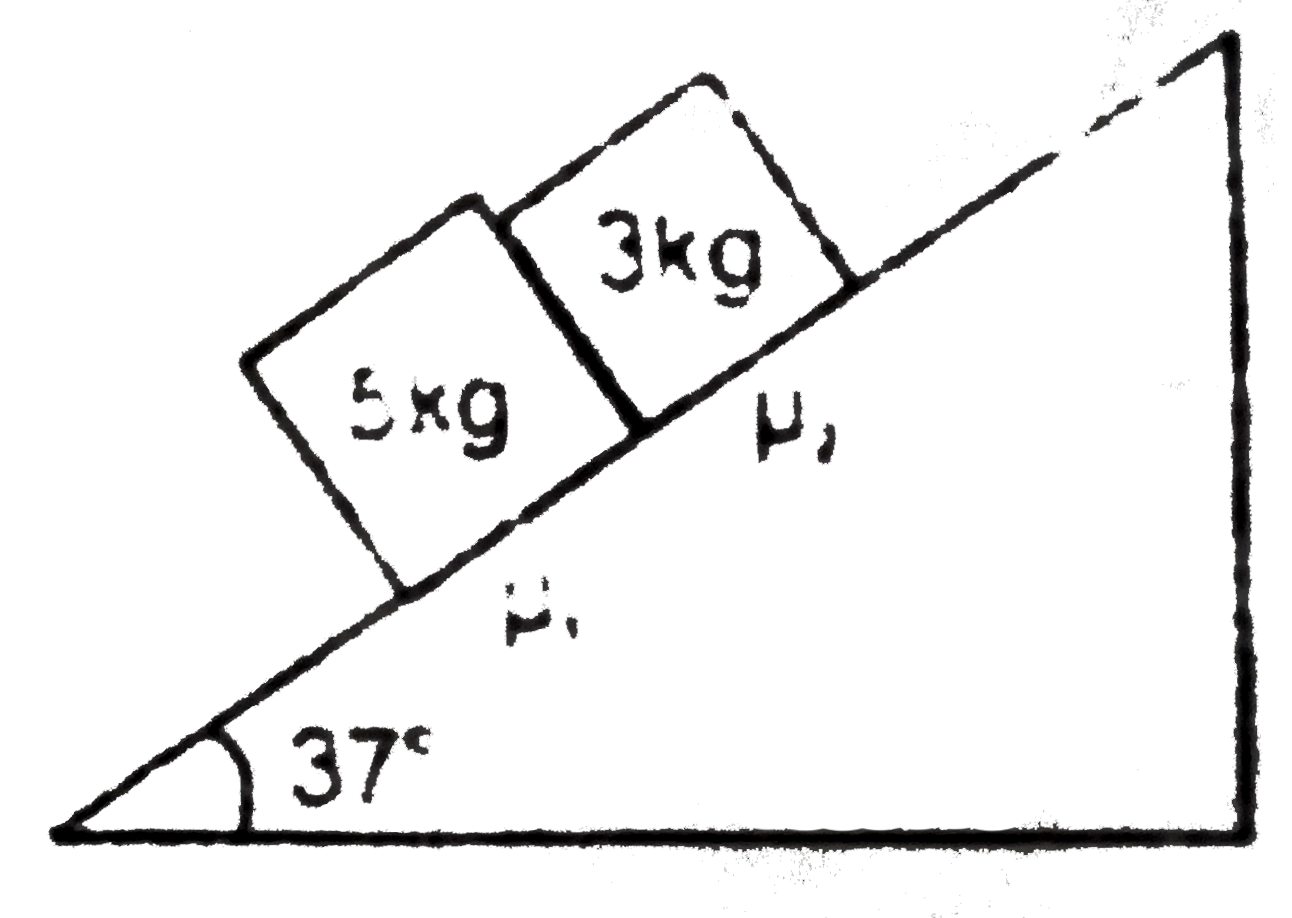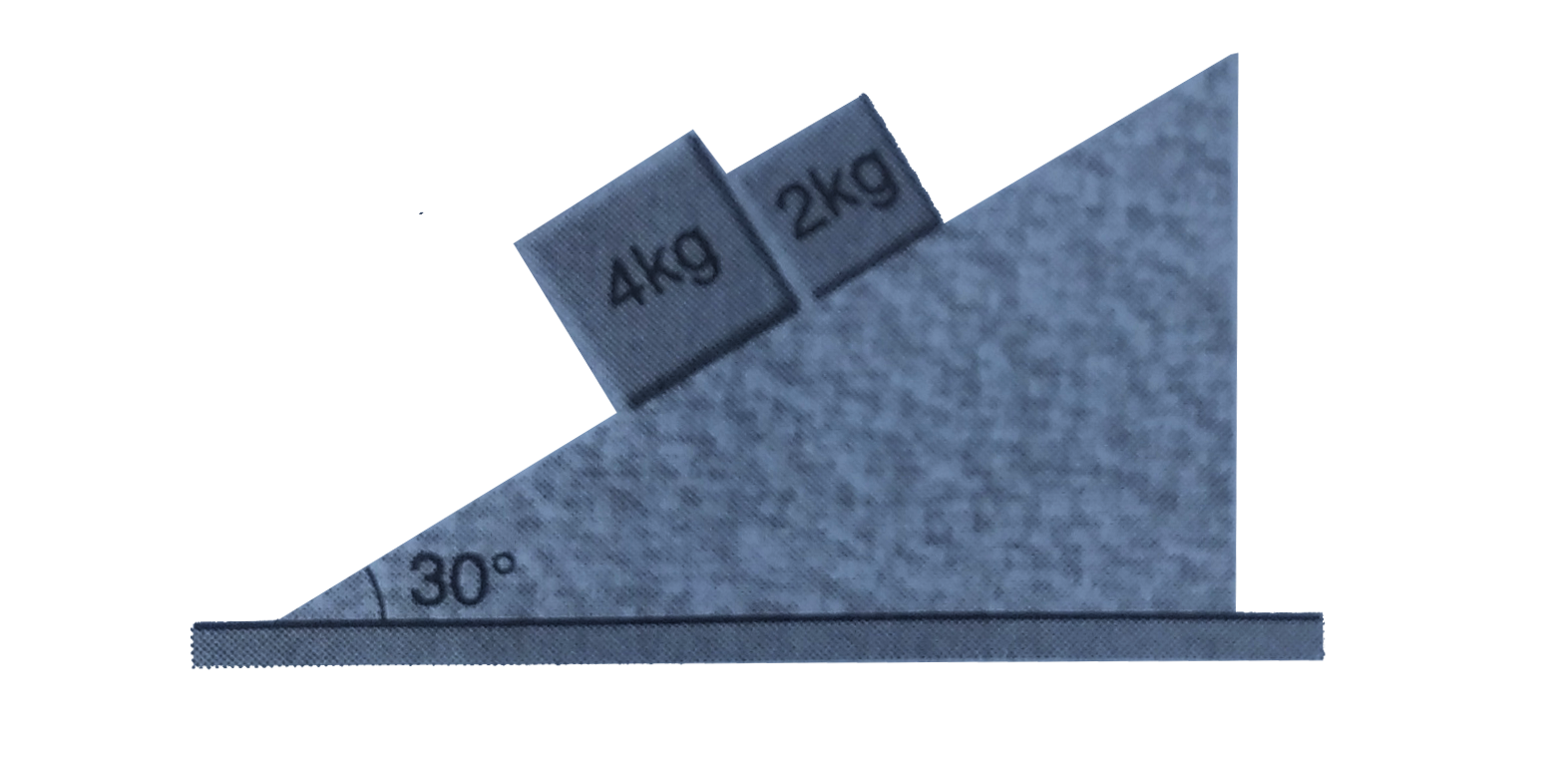Two blocks of masses 5 kg and 3 kg are placed in contact over an inclined surface of angle 37∘, as shown. μ1 is friction coefficient between 5 kg block and the surface of the incline and similarly, μ2 is friction coefficient betweem the 3 kg block and the surface of the incline. After the release of the blocks from the inclined surface.

a. If μ1=0.5 and μ2=0.3 then 5 kg block exerts 3 N force on the 3 kg block
b. If μ1=0.5 and μ2=0.3 then 5kg block exerts 8 N force on the 3 kg block
c. If μ1=0.3 and μ2=0.5 then 5 kg block exerts 1 N on the 3 kg block
d. If μ1=0.3 and μ2=0.5 then 5 kg block exerts no force on the 3 kg block.
The correct Answer is:A, D
Case I : μ1=0.5,μ2=0.3
Along the incline, acceleration of 5 kg block will be less than acceleration of 3 kg block provided they move alone on the incline. The reason is greater friction coefficient of 5 kg block, as acceleration along the incline is g=sinθ−μgcosθ
One to the contain, both blocks will move together. In this case FBDs of both are shown.

For 5 kg block
m1gsinθ+N−μ1m1gcosθ=m1a
For 3kg block
m2gsinθ−N−μ2m2gcosθ=m2a.
Topper's Solved these Questions
- DAILY PRACTICE PROBLEMBOOK - RESONANCE ENGLISHCHAPTER - DAILY PRACTICE PROBLEMEXERCISE - DPP No.35
20 Videos
- DAILY PRACTICE PROBLEMBOOK - RESONANCE ENGLISHCHAPTER - DAILY PRACTICE PROBLEMEXERCISE - DPP No.36
20 Videos
- DAILY PRACTICE PROBLEMBOOK - RESONANCE ENGLISHCHAPTER - DAILY PRACTICE PROBLEMEXERCISE - DPP No.33
20 Videos
- CURRENT ELECTRICITYBOOK - RESONANCE ENGLISHCHAPTER - CURRENT ELECTRICITYEXERCISE - High Level Problems (HIP)
19 Videos
- ELECTRO MAGNETIC WAVESBOOK - RESONANCE ENGLISHCHAPTER - ELECTRO MAGNETIC WAVESEXERCISE - Exercise 3
27 Videos
Similar Questions
Two block of masses 2kg and 4kg are released from rest over a smooth inclined place of inclination 30∘ as shown in figure what is the normal force between the two blocks?

View SolutionFigure shown two blocks in contact sliding down an inclined surface of inclination 30∘. The friction coefficient between block of mass 2kgand the incline is μ1=0.20 and that between the block of mass 4kg and the incline is μ2=0.30 .Find the acceleration of 2.0kg block g=10ms−2

View Solution
Knowledge Check
Two blocks A and B of masses 10 kg and 15 kg are placed in contact with each other rest on a rough horizontal surface as shown in the figure. The coefficient of friction between the blocks and surface is 0.2. A horizontal force of 200 N is applied to block A. The acceleration of the system is (Take g=10ms−2)
 A4ms−2B6ms−2C8ms−2D10ms−2
A4ms−2B6ms−2C8ms−2D10ms−2
A block of mass m=4kg is placed over a rough inclined plane as shown in fig . The coefficient of friction between the block and the plane μ=0.5 A force F=10N is applied on the block at an angle of 30∘. Find the contact force between the block and the plane.
k

View SolutionA block of mass "5kg" is placed on a wedge having inclination of 37∘ with the horizontal. Coefficient of friction between block and wedge is 0.8. Then select the correct statement.

View SolutionA block of mass 10 kg is placed on rough inclined plane of inclination angle 37∘ .Coefficient of friction between block & plane is 0⋅8, find minimum magnitude of F so that block remains at rest .

View SolutionA block of mass m is moving on a rough horizontal surface. μ is the coefficient of kinetic friction between the block and the surface. What is the net force exerted by the surface on the block?
View SolutionTwo blocks of masses 3kg and 2kg are placed side by side on an inclined as shown in figuire A force F=292A force F=20N is active on 2kg block along the inclined .The coefficient of friction between the block and the inclined is same and equal to 0.1 .Find the normal force exerted by 2kg block on 3kgblock

View Solution_E01_099_Q01.png)
A sylindrical vessel filled with water is released on an inclined surface of angle θ as shown in figure the friction coefficient of surface with vessel is μ(<tanθ) then the constant angle made by the surface of water with the incline will be
View SolutionIn the figure shown, if friction coefficient of block 1 kg and 2kg with inclined plane is μ1=0.5 and μ2=0.4 respectively, then

View Solution
